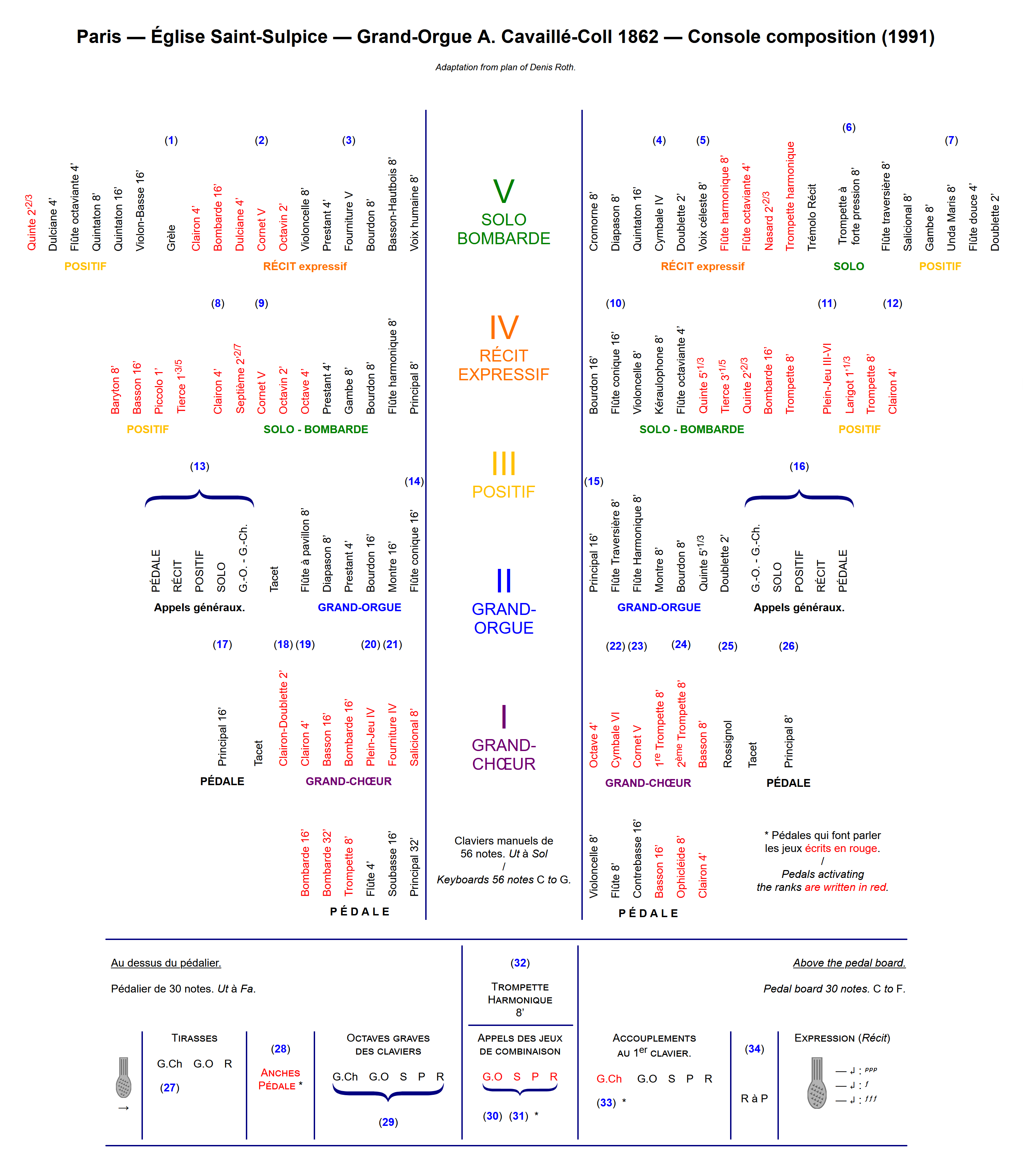Setting the stops
The Grand Orgue of St. Sulpice is equipped with a single-level combination action system that operates separately on the Pedal, Recit, Positif, Solo, and Grand Orgue/Grand Choeur divisions. The system is quite ingenious given that the technology dates from the 1860s and is still perfectly functional. The memory elements are sophisticated pneumatic bellows that store the settings for each stop on the organ.
The “appel général” (General Presets) are used to recall stored stop settings for each of the divisions. These stop settings are recalled simply by pulling the appropriate knob of the corresponding keyboard. These preset controls are located on either the left or right side of the keyboards on the third row from the bottom (13) (16). For the stops indicated in red, it is also necessary to push the foot lever corresponding to the keyboard of interest (28) (31) (33).
To make use of the “appels généraux”, simply follow these steps:
1) Select the first registration by pulling the appropriate stops while the “appel général” knob of the corresponding manual is pushed in.
2) Pull the “appel général” of the corresponding manual. This will allow the combination of selected stops from the first registration to sound.
3) Push in the “appel général” of the corresponding manual. This sets the first registration.
4) Push in all the stops of the first registration, then pull the stops of the second registration. The first registration still sounds.
5) When you desire the second registration to sound, pull the corresponding “appel général” of the manual to be hear with the second registration.
Note that the “appel général” controls do not affect the following stops and accessories: high pressure Trompette Harmonique, couplers, “jeux de combinaison” ventil pedals, Récit tremolo, Rossignol, Grèle. When many stops must be pulled, it is preferable to draw them together via the “appel général” controls.
Notes on the console map
- imitates rain or hail storm
- begins at C3
- see the page Mixture specification
- see the page Mixture specification
- begins at C2, single rank, undulates with the Violoncelle 8′
- “High pressure Trompette harmonique”, can also be drawn via the foot pedal (32)
- to be used with the Salicional 8′
- C1: 4′ , E3: 8′ , E4: 16′
- idem (2)
- begins at C3, first two octaves shared with the Bourdon 16′
- see the page Mixture specification
- C1: 4′ , E4: 8′
- see “Setting the Stops” above
- begins at D3
- begins at D3
- see “Setting the Stops” above
- installed with the Principal 8′ (26) outside the case on the right and left, these two ranks provide some weight to the 8′ and 16′ foundations
- C1: 2′ , C3: 4′ , C4: 8′
- idem (8)
- see the page Mixture specification
- see the page Mixture specification
- see the page Mixture specification
- begins at D3: 8′ , C4: 16′
- C1: 8′ , E3: 16′
- see “Setting the Stops” above
- installed with the Principal 16′ (17) outside the case on the right and left, these two ranks provide some weight to the 8′ and 16′ foundations
- couples the Grand-Choeur onto the Pedal as well as all the keyboards coupled to the Grand-Choeur
- activates all Pedal stops indicated in red
- the “octaves graves” (16′ couplers) also affect any keyboards already coupled: Réc/Pos; Solo, Réc, G.O to I; Grand-Choeur I to Grand-Orgue II and by the Couplers to the Pedal
- couples Grand-Choeur I to Grand-Orgue II even if the lever Grand-Choeur to I (33) is not pushed. (30) + G.O./I causes the Grand-Choeur to be played from I (without (33) being pressed down) and the Grand-Choeur on II. If Gr.Ch./I and G.O./I are not pushed, one could have Solo, Pos, Réc, on I and Gr.Ch. plus G.O. on II
- S, PO, R make the Solo, Positif, Récit stops in red speak
- “High pressure Trompette harmonique”, can also be drawn via the stop (6)
- couples the Grand-Choeur stops onto I
- with the Réc coupled to the Pos and Pos coupled to the Gr.Ch, the Récit becomes also coupled to the Grand-Chœur


